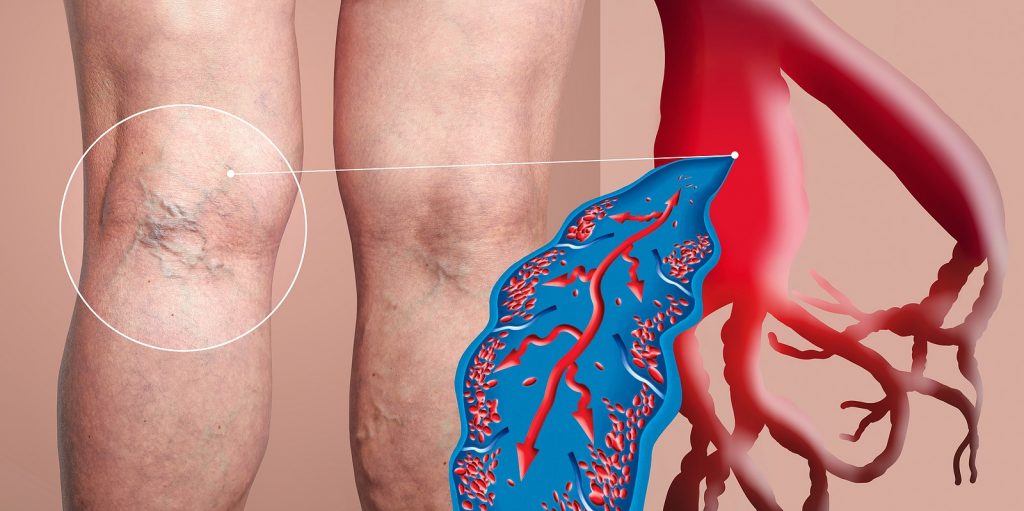
Uneasiness or worrisome physical symptoms are a sign that something is wrong and it is important to be aware of what your symptoms could mean. Sometimes, symptoms and diseases can be treated easily at home but for different cases, it may require professional consultation from a doctor, visiting a clinic or a trip to the ER. If you have symptoms of Deep Vein Thrombosis (DVT), consulting a doctor and speedy treatment is a must. Let’s explore what DVT is.
What is Deep Vein Thrombosis?
A blood clot (thrombus) forms in one or more of your body’s deep veins, generally in your legs, causing deep vein thrombosis (DVT). Deep vein thrombosis can cause limb pain and swelling, but it can also strike without warning. If you have certain medical disorders that alter how your blood clots, you may get DVT. A blood clot in your legs can also occur if you don’t move for an extended period of time, such as after surgery or an accident, while travelling a long distance, or while on bed rest. (Mayo Clinic Staff, 2020)
A blood clot in the veins of the legs is a medical emergency that can result in life-threatening complications. Pulmonary embolism (PE) is the deadliest of these issues. PE occurs when a blood clot breaks off, partially or completely, and travels via the bloodstream to the lungs. It becomes lodged in a blood vessel in the lungs, obstructing blood flow and can cause lifelong lung damage. Due to a shortage of oxygen-rich blood, it can also cause lasting harm to other organs. A PE can cause shock, cardiac arrest, or death if left untreated. (Lewis, 2020)
Symptoms of DVT
DVT is most commonly found in the lower leg, thigh, or pelvis. It affects your arms less frequently. It isn’t always accompanied by symptoms. However, when it develops, the affected area of your body may become swollen, tender to the touch or painful, warm, or achy, crampy or possibly discolored or red.
You don’t necessarily have a deep-vein clot if you experience one or more of these symptoms. A muscle injury, swollen veins beneath the skin’s surface, or a bacterial skin infection known as cellulitis are all illnesses that might elicit comparable symptoms. (Bhargava, 2021)
Prevention of Deep Vein Thrombosis (DVT)
To prevent deep vein thrombosis, one should follow certain measures as those who have had recent surgery, are inactive, pregnant or obese are more at risk of suffering from deep vein thrombosis. The measures are:
Avoid Sitting Still
If you’ve had surgery or have been on bed rest for any reason, try to get up and get moving as soon as possible. If you’re going to be sitting for a long time, don’t cross your legs because this can cut off blood flow. If you’re driving a long distance, take a break every few hours and go for a stroll. If you’re flying, get up and move around every now and then. If you’re unable to do so, work on moving your lower legs.
No Smoking
Smoking increases your chances of DVT and can lead to complications like pulmonary embolism, which can cause death.
Treatment of Deep Vein Thrombosis (DVT)
Medical treatment for DVT will prevent the clot from developing, causing a PE, and lowering the risk of future clots. Anticoagulant medications, often known as blood thinners, are commonly used in this situation. An injectable anticoagulant will most likely be given to you in the ER. Once you leave the ER, you can take other forms at home like pills.
DVT may require more intensive therapy at times. Clot-busting medications (thrombolytics) are used to destroy the clot, as well as surgery to install a vena cava filter. A clot will be caught by the filter before it can reach the lungs. Some DVT blood clots just need to be monitored with ultrasonography on a regular basis. (Lewis, 2020)
If you do develop symptoms of DVT, consult your doctor or seek emergency help if you can’t reach your doctor. Signs of Pulmonary Embolism are shortness of breath, chest pain, coughing, sweating or fast breath. In such a case, call 911 immediately. Instant treatment and measures of prevention can help avoid clots in the future and help you lead a long and healthy life.
Works Cited
Bhargava, Hansa D. “What to Expect at the Doctor or ER for DVT.” WebMD, WebMD, 5 Feb. 2021, www.webmd.com/dvt/dvt-doctor-er-visit.
Lewis, Sarah PharmD. “Is Deep Vein Thrombosis an Emergency?” Healthgrades, Healthgrades, 17 Sept. 2020, www.healthgrades.com/right-care/vascular-conditions/is-deep-vein-thrombosis-an-emergency.
“Deep Vein Thrombosis (DVT).” Mayo Clinic, Mayo Foundation for Medical Education and Research, 22 Dec. 2020, www.mayoclinic.org/diseases-conditions/deep-vein-thrombosis/symptoms-causes/syc-20352557.
